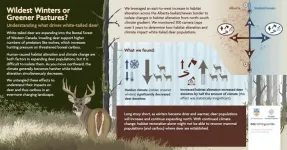(Press-News.org) As the climate changes, animals are doing what they can to adapt.
Researchers from UBC Okanagan—which includes partners from Biodiversity Pathways’ Wildlife Science Centre, the Alberta Biodiversity Monitoring Institute, the University of Alberta, and Environment and Climate Change Canada—wanted to evaluate why deer densities in the boreal forest are rapidly increasing.
Over the past century, white-tailed deer have greatly expanded their range in North America, explains Melanie Dickie, a doctoral student with UBC Okanagan’s Wildlife Restoration Ecology Lab.
In the boreal forest of Western Canada, researchers have considered that both changing climate and increased habitat alteration have enabled deer to push farther north. Climate change can create milder winters, while habitat alteration from forestry and energy exploration creates new food sources for deer.
As they conclude their study, researchers caution that what is good for the deer isn’t necessarily suitable for other species, such as the threatened woodland caribou.
Dickie, as well as fellow UBCO and Biodiversity Pathways researchers Drs. Adam Ford, Michael Noonon, Robin Steenweg and Rob Serrouya, have monitored the white-tailed deer’s movement into the western boreal forest for more than five years.
As global temperatures climb, the researchers note that deer expansion is uprooting existing predator-prey dynamics.
“The expansion of white-tailed deer into the boreal forest has been linked to caribou declines,” explains Dickie. “Deer are ecosystem disruptors in the northern boreal forests. Areas with more deer typically have more wolves, and these wolves are predators of caribou—a species under threat. Deer can handle high predation rates, but caribou cannot.”
Understanding white-tailed deer populations continues to be one piece of the caribou recovery puzzle.
“The trick is that human land use and climate are often intertwined. As we move northward, the climate becomes harsher and human land use decreases, making it difficult to isolate these two factors,” says Dr. Serrouya. “The debate over the relative effect of climate or habitat change isn’t unique to deer in the boreal, either; it’s one of the most pressing issues facing applied ecologists globally.”
The researchers determined that the northern Alberta-Saskatchewan border provided a convenient experimental location. While both sides have a consistent climate, habitat alteration is, on average, 3.6-fold higher on the Alberta side.
Between 2017 and 2021, the research team maintained 300 wildlife cameras throughout the region to collect motion-triggered images of large mammals. These images were used to estimate white-tailed deer density.
Key findings from the study include that deer density was significantly lower in areas with colder, snowier winters. While human land use was associated with higher deer densities, the effect of human-caused habitat change was much smaller than that of climate.
Winter severity is expected to decline as climate change progresses. This means that deer are expected to keep expanding northwards and increase in abundance, adding an increased risk to the caribou.
“When planning for caribou recovery, we need to consider these new forest residents,” says Dr. Ford. “We are now well into the United Nations Decade on Ecosystem Restoration, but when doing restoration, we have to account for new pathways of species interacting in the food web.”
The research was published today in the journal Global Change Biology.
END
Deer are expanding north, and that’s not good for caribou
Researchers examine warming climate, human land use opening boreal forest to deer
2024-04-25
ELSE PRESS RELEASES FROM THIS DATE:
Puzzling link between depression and cardiovascular disease explained at last: they partly develop from the same gene module
2024-04-25
Depression and cardiovascular disease (CVD) are serious concerns for public health. Approximately 280 million people worldwide have depression, while 620 million people have CVD. It has been known since the 1990s that the two diseases are somehow related. For example, people with depression run a greater risk of CVD, while effective early treatment for depression cuts the risk of subsequently developing CVD by half. Conversely, people with CVD tend to have depression as well. For these reasons, the American Heart Association (AHA) advises to monitor teenagers with depression ...
Synthetic droplets cause a stir in the primordial soup
2024-04-25
Our bodies are made up of trillions of different cells, each fulfilling their own unique function to keep us alive.
How do cells move around inside these extremely complicated systems? How do they know where to go? And how did they get so complicated to begin with? Simple yet profound questions like these are at the heart of curiosity-driven basic research, which focuses on the fundamental principles of natural phenomena. An important example is the process by which cells or organisms move in response to chemical signals in their environment, also known as chemotaxis.
A constellation of researchers from three different research units at the Okinawa Institute of Science ...
Future parents more likely to get RSV vaccine when pregnant if aware that RSV can be a serious illness in infants
2024-04-25
A nationwide survey of people who were pregnant or trying to become pregnant found that overall 54 percent expressed interest in the RSV vaccine during pregnancy. Perceiving RSV as a serious illness in infants was the strongest predictor of likely vaccination during pregnancy. Likelihood to receive the RSV vaccine during pregnancy was also higher among parents with a child at home already. Findings were published in the journal Pediatrics.
Respiratory syncytial virus (RSV) is a leading cause of infection among infants, frequently resulting in hospital or intensive care admission. RSV infection severe enough to require hospitalization has been associated with long-term wheezing ...
Microbiota enterotoxigenic Bacteroides fragilis-secreted BFT-1 promotes breast cancer cell stemness and chemoresistance through its functional receptor NOD1
2024-04-25
Tumor-resident microbiota in breast cancer promotes both the initiation and progression of cancer. However, the potential of targeting microbiota to enhance the efficacy of breast cancer treatment has not been comprehensively explored. In this study, researchers analyzed the microbial composition within breast tumors and identified a notable enrichment of ETBF in patients who exhibited resistance to taxane-based neoadjuvant chemotherapy.
Key findings from the study include:
Even at low biomass levels, ETBF ...
The Lundquist Institute receives $2.6 million grant from U.S. Army Medical Research Acquisition Activity to develop wearable biosensors
2024-04-25
The U.S. Army Medical Research Acquisition Activity (USAMRAA) has awarded The Lundquist Institute (TLI) a four-year grant totaling $2,623,234. The research project is led by Dr. Harry Rossiter, an investigator at TLI and Professor at the David Geffen School of Medicine at UCLA. The project aims to develop wearable multiplex biosensors to monitor exacerbation risk in chronic obstructive pulmonary disease (COPD).
COPD affects approximately 16 million Americans and is the third leading cause of death globally. Acute exacerbations of COPD (AECOPD), typically caused by a lung infection, are associated ...
Understanding the cellular mechanisms of obesity-induced inflammation and metabolic dysfunction
2024-04-25
A research team led by Professor Jong Kyoung Kim and Yujin Jeong (PhD candidate), from the Department of Life Sciences at Pohang University of Science and Technology (POSTECH) in collaboration with Professor Yun-Hee Lee and Cheoljun Choi (PhD candidate) from the College of Pharmacy at Seoul National University, Professor Young-Min Hyun and Koung-Min Park (PhD candidate) from Yonsei University College of Medicine, Professor James Granneman from Wayne State University (WSU), and Professor Young-Suk Jung from the College of Pharmacy at Pusan National University, ...
Study highlights increased risk of second cancers among breast cancer survivors
2024-04-25
Survivors of breast cancer are at significantly higher risk of developing second cancers, including endometrial and ovarian cancer for women and prostate cancer for men, according to new research studying data from almost 600,000 patients in England.
For the first time, the research has shown that this risk is higher in people living in areas of greater socioeconomic deprivation.
Breast cancer is the most commonly diagnosed cancer in the UK. Around 56,000 people in the UK are diagnosed each year, the vast majority (over 99%) of whom are women. Improvements in earlier diagnosis and in treatments mean that ...
International DNA Day launch for Hong Kong’s Moonshot for Biology
2024-04-25
International DNA Day Launch for Hong Kong’s Moonshot for Biology
The first emblematic species sequenced by the Hong Kong Biodiversity Genomics Consortium are published to coincide with International DNA Day. Joining a global “moonshot for biology” that aims to sequence, catalogue, and characterize the genomes of all of Earth's eukaryotic biodiversity.
A significant portion of modern knowledge in biology has emerged through sequencing the genetic code of the world’s biodiversity, which to date has been largely uncharacterized and increasingly ...
New scientific resources map food components to improve human and environmental health
2024-04-25
DALLAS, April 24, 2024 — The Periodic Table of Food Initiative ('the Initiative'), a pioneering collaboration led by the American Heart Association, the Alliance of Bioversity and CIAT, with support from The Rockefeller Foundation, has unveiled an initial suite of scientific tools, data, and training aimed at revolutionizing global agriculture and nutrition. This first phase introduces two data interfaces–the PTFI MarkerLab interface and the American Heart Association Precision Medicine Platform–which provide standardized data on the biomolecular composition of 500 foods that are representative of global consumption. ...
Mass General Brigham research identifies pitfalls and opportunities for generative artificial intelligence in patient messaging systems
2024-04-25
Study found GPT-4-generated messages to patients were acceptable without any additional physician editing 58% of the time and provided more detailed educational information than those written by physicians
AI-generated messages had shortcomings, including 7% of responses being deemed unsafe if left unedited
Generative AI may promote efficiency and patient education, but require a “doctor in the loop” and a cautious approach as hospitals integrate algorithms into electronic health records
A new study by investigators from Mass General Brigham demonstrates that large language models (LLMs), a type of generative ...
LAST 30 PRESS RELEASES:
Post-stroke injection protects the brain in preclinical study
Cardiovascular risk score predicts multiple eye diseases
Health: estimated one in ten British adults used or interested in GLP-1 medications for weight loss
Exercise to treat depression yields similar results to therapy
Whooping cough vaccination for pregnant women strengthens babies’ immune system
Dramatic decline in new cases of orphanhood in Uganda driven by HIV treatment and prevention programs
Stopping weight loss drugs linked to weight regain and reversal of heart health markers
Higher intake of food preservatives linked to increased cancer risk
Mass General Brigham–developed cholera vaccine completes phase 1 trial
First experimental validation of a “150-year-old chemical common sense” direct visualization of the molecular structural changes in the ultrafast anthracene [4+4] photocycloaddition reaction
Lack of support for people on weight loss drugs leaves them vulnerable to nutritional deficiencies, say experts
Dogs’ dinners can have greater climate impact than owners’
Are you ready to swap salmon for sprats and sardines?
1.6 million UK adults used weight loss drugs in past year
American College of Cardiology comments on new dietary guidelines for Americans
American Society of Gene & Cell Therapy and Orphan Therapeutics Accelerator partner to advance and commercialize promising rare disease treatments
One in 14 patients having day case surgery have new or worse chronic pain 3 months after their operation
New study highlights link between eviction rates and gun violence
Heatwaves heat up soil but not toxin levels in rice, study finds
Digital modeling reveals where construction carbon emissions really come from
Turning farm waste into water filters
New study shows how the spleen helps the immune system accept a transplant
New Mayo Clinic study advances personalized prostate cancer education with an EHR-integrated AI agent
Researchers identify novel therapeutic target to improve recovery after nerve injury
Microbes in breast milk help populate infant gut microbiomes
Reprogramming immunity to rewrite the story of Type 1 diabetes
New tool narrows the search for ideal material structures
Artificial saliva containing sugarcane protein helps protect the teeth of patients with head and neck cancer
Understanding the role of linear ubiquitination in T-tubule biogenesis
Researchers identify urban atmosphere as primary reservoir of microplastics
[Press-News.org] Deer are expanding north, and that’s not good for caribouResearchers examine warming climate, human land use opening boreal forest to deer








